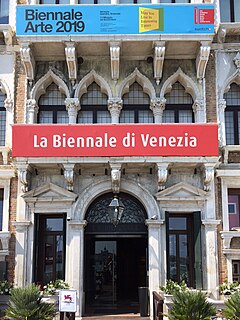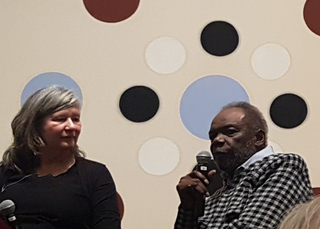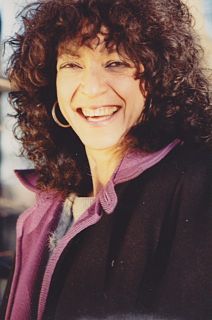Juan Downey was a Chilean artist who was a pioneer in the fields of video art and interactive art.

The Venice Biennale is an arts organization based in Venice and the name of the original and principal biennial exhibition the organization presents. The organization changed its name to the Biennale Foundation in 2009, while the exhibition is now called the Art Biennale to distinguish it from the organization and other exhibitions the Foundation organizes.

Biennale, Italian for "biennial" or "every other year", is any event that happens every two years. It is most commonly used within the art world to describe large-scale international contemporary art exhibitions. As such the term was popularised by Venice Biennale, which was first held in 1895. The phrase has since been used for other artistic events, such as the "Biennale de Paris", "Kochi-Muziris Biennale", or even as a portmanteau as with Berlinale and Viennale. "Biennale" is therefore used as a general term for other recurrent international events.

Robert Gober is an American sculptor. His work is often related to domestic and familiar objects such as sinks, doors, and legs.

Sam Gilliam is an African-American color field painter and lyrical abstractionist artist. Gilliam is associated with the Washington Color School, a group of Washington, D.C. area artists that developed a form of abstract art from color field painting in the 1950s and 1960s. His works have also been described as belonging to abstract expressionism and lyrical abstraction. He works on stretched, draped and wrapped canvas, and adds sculptural 3D elements. He is recognized as the first artist to introduce the idea of a draped, painted canvas hanging without stretcher bars around 1965. This was a major contribution to the Color Field School.

Fred Wilson in the Bronx, New York - is an American artist and describes himself as of "African, Native American, European and Amerindian" descent. He received a BFA from Purchase College, State University of New York. Wilson challenges colonial assumptions on history, culture, and race – encouraging viewers to consider the social and historical narratives that represent the western canon. Wilson received a MacArthur Foundation "genius grant" in 1999 and the Larry Aldrich Foundation Award in 2003. Wilson represented the United States at the Biennial Cairo in 1992 and the Venice Biennale in 2003. In May 2008, it was announced that Wilson would become a Whitney Museum trustee replacing Chuck Close.
Ileana Sonnabend was a Romanian-American art dealer of 20th-century art. The Sonnabend Gallery opened in Paris in 1962 and was instrumental in making American art of the 1960s known in Europe, with an emphasis on American Pop Art. In 1970, Sonnabend Gallery opened in New York on Madison Avenue and in 1971 relocated to 420 West Broadway in SoHo where it was one of the major protagonists that made SoHo the international art center it remained until the early 1990s. The gallery was instrumental in making European art of the 1970s known in America, with an emphasis on European conceptual art and Arte Povera. It also presented American conceptual and minimal art of the 1970s. In 1986, the so-called “Neo-Geo” show introduced, among others, the artist Jeff Koons. In the late 1990s, the gallery moved to Chelsea and continues to be active after Sonnabend's death. The gallery goes on showing the work of artists who rose to prominence in the 1960s and 1970s like Robert Morris, Bernd and Hilla Becher and Gilbert & George as well as more recent artists like Jeff Koons, Rona Pondick, Candida Höfer, Elger Esser, and Clifford Ross among others.
Ashley Bickerton is a contemporary artist. A mixed-media artist, Bickerton often combines photographic and painterly elements with industrial and found object assemblages. He is associated with the early 1980s art movement Neo-Geo.
Kai Althoff is a German visual artist and musician.
Herman Trunk, also known as Herman Trunk Jr., was an American painter active in the modernist movement of the 1920s and 1930s. He exhibited alongside some of the most famous artists of the day. At present his contributions to figurative abstract art are being recovered by scholars and critics. His work was part of the painting event in the art competition at the 1932 Summer Olympics.
Troy Brauntuch is an American artist. He lives in Austin, Texas.
Bill Beckley is an American narrative/conceptual artist.
Lavar Munroe is a Bahamian-American artist, working primarily in painting, cardboard sculptural installations, and mixed media drawings. His work is often categorized as: a hybrid medium that straddle the line between sculpture and painting. Munroe lives and works in the United States.

Kim Levin is an American art critic and writer. Levin was a regular contributor to The Village Voice from 1982 to 2006. Since 2007 she has been contributing regularly to ArtNews.

Kimsooja is a South Korean, multi-disciplinary conceptual artist based in New York, Paris, and Seoul. Her practice combines performance, film, photo, and site-specific installation using textile, light, and sound. Kimsooja's work investigates questions concerning the conditions of humanity, while engaging issues of aesthetics, culture, politics, and the environment. Her principle of ‘non-doing’ and ‘non-making,’ which follows a conceptual and structural investigation of performance through modes of mobility and immobility, inverts the notion of the artist as the predominant actor.
The American pavilion is a national pavilion of the Venice Biennale. It houses the United States' official representation during the Biennale.
The 58th Venice Biennale was an international contemporary art exhibition held between May and November 2019. The Venice Biennale takes place biennially in Venice, Italy. Artistic director Ralph Rugoff curated its central exhibition, May You Live in Interesting Times, and 90 countries contributed national pavilions.
The 45th Venice Biennale, held in 1993, was an exhibition of international contemporary art, with 45 participating nations. The Venice Biennale takes place biennially in Venice, Italy. Prizewinners of the 45th Biennale included: ex aequo Richard Hamilton and Antoni Tàpies, Robert Willson, the German pavilion with Hans Haacke and Nam June Paik, and Matthew Barney.
The 17th Venice Biennale, held in 1930, was an exhibition of international contemporary art, with 11 participating nations. The Venice Biennale takes place biennially in Venice, Italy.
Alban Muja is a Kosovan contemporary artist and film-maker. In 2019 he represented Kosovo at the 58th Venice Biennale. In his work he is mostly influenced by the social, political and economical transformation processes in wider surrounding region, he investigates history and socio-political themes and links them to his position in Kosovo today. His works cover a wide range of media including video installation, films, drawings, paintings, photographs and performance which have been exhibited extensively in various exhibitions and festivals.







